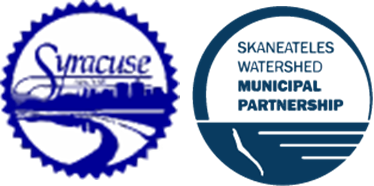Hemlock Woolly Adelgid (HWA)
The Hemlock Woolly Adelgid (HWA) is an insect native to Asia that reached New York in the 1980’s. The insect targets Hemlock trees, including Eastern Hemlocks, which are abundant in NYS. HWA lives and feeds on hemlock trees. The HWA is spread by the wind, by birds, or by humans or other animals - infestations do not spread by flying HWA. The HWA is active during the winter, which allows it to avoid predators (which are generally active during the summer) and to take advantage of the hemlock's increased energy intake during the winter. Although the insect itself is tiny, during most times of the year the HWA can be found and recognized because of the woolly covering it creates to protect itself and its eggs. HWA can be found on the underside of hemlock branches near the tips, and at the base of the needles. HWA infested trees can take as few as two years after the time of infestation until death, although 10-12 years is more common.
Hemlocks play a critical ecological role, as a "keystone" species, providing many ecosystem services, including protection of water quality. The shade from their branches keeps soil from drying out and creates a cool habitat for plants and animals. Their branches also protect areas from snow and wind in the winter. They also serve as a food source for many animals. Hemlocks are typically found growing next to streams, providing shade that cools the water and keeps aquatic organisms happy. They live a long time (500+ years) and tolerate shade well, which allows them to dominate large stands, which creates a distinct ecosystem. Hemlocks are also aesthetically pleasing to many, and can positively impact nearby property values.
HWA In the Skaneateles Lake Watershed
HWA was identified in the Skaneateles Lake Watershed in 2014. Hemlock loss could impact water quality by chancing nutrient cycling in the watershed, and changing water temperature and quantity going into the lake over the course of the year. HWA has been found on both shores of Skaneateles Lake on the southern portion. As of February 2020, the northernmost points where HWA has been found are in the area of Fire Lane 22A on the western shore, and around Ten Mile Point on the eastern shore.
In an effort to minimize the spread of HWA, the City of Syracuse Water Department has collaborated with the Onondaga County Soil and Water Conservation District, Cornell Cooperative Extension Onondaga County, and several volunteers residing in the watershed. In May 2015, 100 Eastern Hemlock trees were planted within this region of the watershed in an effort to grow populations of biological controls to resist the spread of HWA. Once the trees are large and health enough to sustain low populations of HWA, predator insects will be introduced to feed on HWA, and rear a larger population of predator beetles for introduction throughout the watershed.
Three insects that feed on HWA (biocontrols) have been released in the Skaneateles Watershed in 2015 and 2016. These are a beetle, Laricobius nigrinus, and two species of silver fly, Leucopis piniperda and L. argenticollis. All three species are imported from their native range in the Northwestern US where they are natural predators of HWA. Establishment has not been verified in the Skaneateles watershed for any of the three species, but establishment can take many years to be detected.
To enhance and support this biocontrol management option, in November of 2017 a new, $1.2 million biocontrol laboratory was established on the Cornell University campus, focused on researching and rearing biological controls to stop the spread of HWA. The lab is funded through NYSDEC’s monies from the NYS Environmental Protection Fund and is headed by a Cornell entomologist. Biological control is a long-term solution for HWA, but landowners with trees that are currently infested are strongly encouraged to consider treatment of their trees. Treatment is relatively inexpensive and lasts for 3-7 years.
Recently, OCSWCD has received a grant for HWA treatment and scouting from the USFS Great Lakes Restoration Initiative and titled “Hemlock Woolly Adelgid Treatment in Skaneateles and Otisco Lake Watersheds.”
For more information, check out these resources:
“The Living System” video of Bob Duckett talking about hemlocks
CCE Onondaga Managing Forests for Hemlock Woolly Adelgid Brochure
USDA Eastern Hemlock Forests: Guidelines to Minimize the Impacts of Hemlock Woolly Adelgid
NYS Hemlock Initiative Hemlock and HWA Hunters HWA Survey Protocol
NYS Hemlock Initiative Landowner Hemlock Prioritization Toolkit
Skaneateles Lake Association List of Treatment Professionals
Biological control of hemlock woolly adelgid in North America: History, status, and outlook (article in Biological Control)
Environmental Risks to Arthropods from Imidacloprid Applications for Hemlock Conservation (from the University of Georgia, more accessible language)
Zebra and Quagga Mussels
Zebra mussels (Dreissena polymorpha) and quagga mussels (D. bugensis) were introduced into the Great Lakes in the mid- to late-1980s from freshwater ballast discharged from freighters originating in the Black and Caspian Sea region of eastern Europe and western Asia. They filter vast amounts of plankton, decreasing the food source of other species and subsequently causing a lack of clarity in the water (from NY SeaGrant). Both zebra and quagga mussels inhabit Skaneateles Lake.
Preventing the Spread of Zebra ANd quagga Mussels
CLEAN: your boat, trailer and gear by removing all plants, animals and foreign objects.
DRAIN: all water from the boat, including the motor, bilge, live wells and bait buckets, before leaving the lake.
DRY: boat, trailer and gear at least 5 days before entering another water body. If unable to let it dry for at least 5 days, rinse equipment and watercraft (with high pressure, hot water when possible) and wipe with a towel before reuse.
DISPOSE of unwanted live bait and worms in the trash.
NEVER introduce fish, plants, crayfish, snails or clams from one body of water to another.
For more information, check out these resources:
Other Invasive Species Info
For more information on invasive species, check out these resources:

